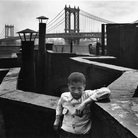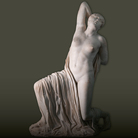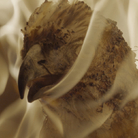Cy Twombly. Paradise

© Cy Twombly Foundation | Cy Twombly, “Untitled (Camino Real V)”, 2011. Acrilico su legno, 252,5 x 187,2 cm
Dal 6 May 2015 al 13 September 2015
Venezia
Luogo: Ca’ Pesaro – Galleria Internazionale d’Arte Moderna
Indirizzo: Santa Croce 2076
Orari: 10-18; chiuso lunedì
Curatori: Julie Sylvester, Philip Larratt-Smith
Costo del biglietto: intero € 10, ridotto € 7.50, scuole 4, gratuito residenti e nati nel Comune di Venezia, bambini da 0 a 5 anni e altre categorie
Telefono per informazioni: +39 041 721127
E-Mail info: capesaro@fmcvenezia.it
Sito ufficiale: http://capesaro.visitmuve.it
Tra i massimi maestri della contemporaneità, Cy Twombly (Lexington, Virginia, 1928 – Roma, 2011)torna a Venezia – dove è stato presente alla Biennale per ben cinque volte a partire dal 1964, l’ultima delle quali nel 2001 dove ottiene il Leone d’Oro – con un’importante mostra monografica curata da Julie Sylvester e Philip Larratt-Smith.
La rassegna, realizzata in collaborazione con la Cy Twombly Foundation di New York, il coordinamento scientifico di Gabriella Belli e il progetto di allestimento di Daniela Ferretti, approda a Ca’ Pesaro come un cammeo prezioso: l’inedita testimonianza di un lavoro che si rigenera a ogni sua apparizione, in un continuum emozionale, e di un artista che non finisce di stupire “per la straordinaria intelligenza visiva e l’acuta sensibilità verso tutte le forme della bellezza, fisica, naturale e artistica”, come scrive Philip Larratt-Smith nel catalogo (ed Damiani).
Cy Twombly Paradise è un percorso iniziatico che attraversa sessant’anni della produzione di Twombly pittore e scultore e della sua indefessa creatività, che a Venezia ritrova – in un contesto culturale che mantiene sempre altissima l’attenzione del pubblico verso i grandi maestri – una nuova prospettiva sui misteri e le rivelazioni dell’arte di Twombly.
L’opera di Cy Twombly, scomparso nel 2011, ruota intorno ai temi universali di amore, arte, bellezza e morte, tuttavia la peculiarità della sua visione artistica, la sua prospettiva del mondo ne offrono un’interpretazione straordinariamente originale. Come molti della sua generazione, Twombly ha reagito contro la tendenza pittorica dominante dell’Espressionismo Astratto, ma a differenza di altri, indirizzati verso l’immaginario Pop e il Neodadaismo, egli ha operato una sintesi tra i lasciti e le tecniche consolidate dell’astrazione gestuale e la tradizione della pittura europea.
L’innovativo uso del linguaggio, l’ampio raggio di allusioni e riferimenti aprono il suo lavoro alla storia, alla letteratura e alla filosofia; rendendo labili i confini tra pittura, disegno e scrittura, preservando allo stesso tempo un alto grado di astrazione.
L’amore per il vernacolo è controbilanciato da una raffinatezza e una profonda conoscenza culturale. Invero, il suo lavoro oscilla tra binomi opposti: ragione e passione, rappresentazione e astrazione, apollineo e dionisiaco, sessualità e intelletto, passato e presente, immaginazione e osservazione, lucidità e frenesia. Dunque, la sessualità esuberante, il richiamo a un passato arcadico in cui corpo e mente sono armoniosamente unificati, il ricorrere nei lavori di parole, frasi, poesie e, soprattutto, l’astrazione gestuale di Twombly – che ha realizzato disegni al buio, ha dipinto con la mano sinistra, ha aumentato l’estensione del pennello, fissandolo a lunghi bastoni, come strategia cosciente per dimenticare la formazione artistica e perdere il controllo del mezzo tecnico – sono solo alcuni dei temi della sua ricerca creativa, ripercorsa nelle sale monumentali di Ca’ Pesaro.
In mostra, dalle pitture murali su legno datate 1951 si giunge, in un percorso ricco di visioni e richiami,a una selezione degli ultimissimi lavori di Twombly realizzati nel 2011, quando l’artista era al limite fisico della vecchiaia: otto tele di cerchi gestuali barocchi, in giallo, rosso e arancione su un fondo verde brillante (metà margarita, metà key lime); eccentriche pennellate circolari – tra i motivi chiave dell’artista – strette in alcuni punti e più ampie e libere in altri, per generare “una sensazione d’energia radiante e di frenesia controllata”.
“I suoi segni caratteristici, elidenti intenzionalmente dipinti, disegni e scritte, coesistono con gocce, spruzzi e sbavature occasionali lasciate colare sulla superficie, rivelandone il processo creativo”. Create poche settimane e addirittura pochi giorni prima della sua scomparsa, queste superfici lucide e ipnotiche – quattro delle quali esposte in questa occasione – sono state le ultime dipinte dall’artista american o.
Per Twombly l’arte è il “paradiso terrestre”, dove le esperienze e le emozioni del passato sono recuperate e trasfigurate nel presente. L’amore in tutte le sue manifestazioni – erotico, intellettuale, platonico, romantico, amore per la cultura, amore per la vita – è il principio animatore dei suoi dipinti, disegni e sculture. La sua arte è la misteriosa, perfetta unione tra sogno e veglia, passato irrecuperabile e presente percepibile attraverso i sensi, ardore intellettuale e capacità di amare: paradiso riconquistato.
La mostra è organizzata con il supporto della Gagosian Gallery.
La rassegna, realizzata in collaborazione con la Cy Twombly Foundation di New York, il coordinamento scientifico di Gabriella Belli e il progetto di allestimento di Daniela Ferretti, approda a Ca’ Pesaro come un cammeo prezioso: l’inedita testimonianza di un lavoro che si rigenera a ogni sua apparizione, in un continuum emozionale, e di un artista che non finisce di stupire “per la straordinaria intelligenza visiva e l’acuta sensibilità verso tutte le forme della bellezza, fisica, naturale e artistica”, come scrive Philip Larratt-Smith nel catalogo (ed Damiani).
Cy Twombly Paradise è un percorso iniziatico che attraversa sessant’anni della produzione di Twombly pittore e scultore e della sua indefessa creatività, che a Venezia ritrova – in un contesto culturale che mantiene sempre altissima l’attenzione del pubblico verso i grandi maestri – una nuova prospettiva sui misteri e le rivelazioni dell’arte di Twombly.
L’opera di Cy Twombly, scomparso nel 2011, ruota intorno ai temi universali di amore, arte, bellezza e morte, tuttavia la peculiarità della sua visione artistica, la sua prospettiva del mondo ne offrono un’interpretazione straordinariamente originale. Come molti della sua generazione, Twombly ha reagito contro la tendenza pittorica dominante dell’Espressionismo Astratto, ma a differenza di altri, indirizzati verso l’immaginario Pop e il Neodadaismo, egli ha operato una sintesi tra i lasciti e le tecniche consolidate dell’astrazione gestuale e la tradizione della pittura europea.
L’innovativo uso del linguaggio, l’ampio raggio di allusioni e riferimenti aprono il suo lavoro alla storia, alla letteratura e alla filosofia; rendendo labili i confini tra pittura, disegno e scrittura, preservando allo stesso tempo un alto grado di astrazione.
L’amore per il vernacolo è controbilanciato da una raffinatezza e una profonda conoscenza culturale. Invero, il suo lavoro oscilla tra binomi opposti: ragione e passione, rappresentazione e astrazione, apollineo e dionisiaco, sessualità e intelletto, passato e presente, immaginazione e osservazione, lucidità e frenesia. Dunque, la sessualità esuberante, il richiamo a un passato arcadico in cui corpo e mente sono armoniosamente unificati, il ricorrere nei lavori di parole, frasi, poesie e, soprattutto, l’astrazione gestuale di Twombly – che ha realizzato disegni al buio, ha dipinto con la mano sinistra, ha aumentato l’estensione del pennello, fissandolo a lunghi bastoni, come strategia cosciente per dimenticare la formazione artistica e perdere il controllo del mezzo tecnico – sono solo alcuni dei temi della sua ricerca creativa, ripercorsa nelle sale monumentali di Ca’ Pesaro.
In mostra, dalle pitture murali su legno datate 1951 si giunge, in un percorso ricco di visioni e richiami,a una selezione degli ultimissimi lavori di Twombly realizzati nel 2011, quando l’artista era al limite fisico della vecchiaia: otto tele di cerchi gestuali barocchi, in giallo, rosso e arancione su un fondo verde brillante (metà margarita, metà key lime); eccentriche pennellate circolari – tra i motivi chiave dell’artista – strette in alcuni punti e più ampie e libere in altri, per generare “una sensazione d’energia radiante e di frenesia controllata”.
“I suoi segni caratteristici, elidenti intenzionalmente dipinti, disegni e scritte, coesistono con gocce, spruzzi e sbavature occasionali lasciate colare sulla superficie, rivelandone il processo creativo”. Create poche settimane e addirittura pochi giorni prima della sua scomparsa, queste superfici lucide e ipnotiche – quattro delle quali esposte in questa occasione – sono state le ultime dipinte dall’artista american o.
Per Twombly l’arte è il “paradiso terrestre”, dove le esperienze e le emozioni del passato sono recuperate e trasfigurate nel presente. L’amore in tutte le sue manifestazioni – erotico, intellettuale, platonico, romantico, amore per la cultura, amore per la vita – è il principio animatore dei suoi dipinti, disegni e sculture. La sua arte è la misteriosa, perfetta unione tra sogno e veglia, passato irrecuperabile e presente percepibile attraverso i sensi, ardore intellettuale e capacità di amare: paradiso riconquistato.
La mostra è organizzata con il supporto della Gagosian Gallery.
SCARICA IL COMUNICATO IN PDF
COMMENTI

-
 Dal 2 December 2025 al 19 February 2026
Milano | Centro Culturale di Milano
Dal 2 December 2025 al 19 February 2026
Milano | Centro Culturale di Milano
Walter Rosenblum. Il mondo e la tenerezza
-
 Dal 30 November 2025 al 12 April 2026
Gallarate | Museo MA*GA
Dal 30 November 2025 al 12 April 2026
Gallarate | Museo MA*GA
Kandinsky e l’Italia
-
 Dal 29 November 2025 al 12 April 2026
Roma | Musei Capitolini
Dal 29 November 2025 al 12 April 2026
Roma | Musei Capitolini
La Grecia a Roma
-
 Dal 22 November 2025 al 3 May 2026
Torino | Sale Chiablese dei Musei Reali
Dal 22 November 2025 al 3 May 2026
Torino | Sale Chiablese dei Musei Reali
Orazio Gentileschi. Un pittore in viaggio
-
 Dal 20 November 2025 al 25 January 2026
Firenze | Palazzo Strozzi
Dal 20 November 2025 al 25 January 2026
Firenze | Palazzo Strozzi
Andro Eradze. Bones of Tomorrow
-
 Dal 21 November 2025 al 28 March 2026
Cuneo | Complesso Monumentale di San Francesco
Dal 21 November 2025 al 28 March 2026
Cuneo | Complesso Monumentale di San Francesco
La Galleria Borghese. Da Raffaello a Bernini. Storia di una collezione


